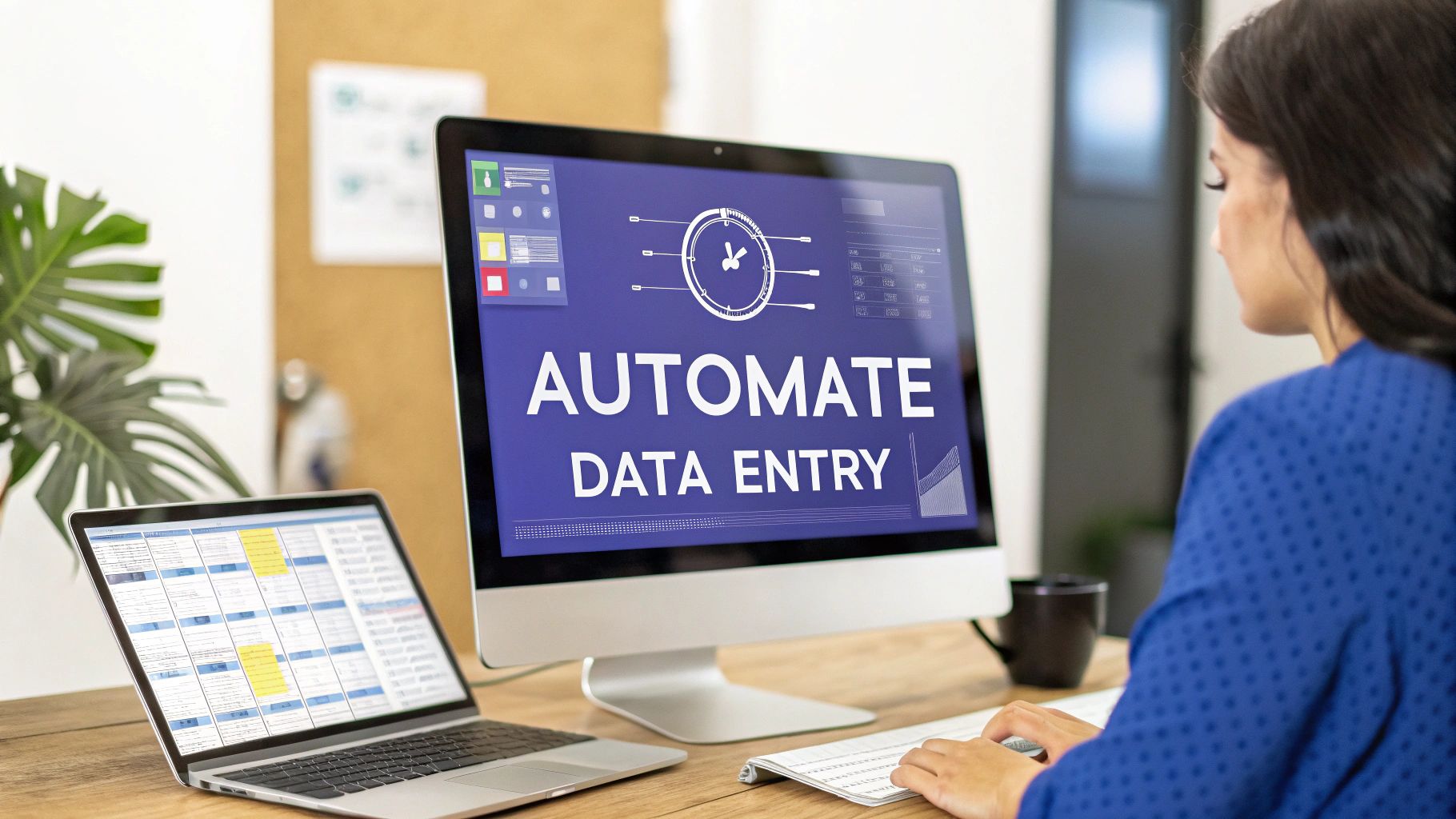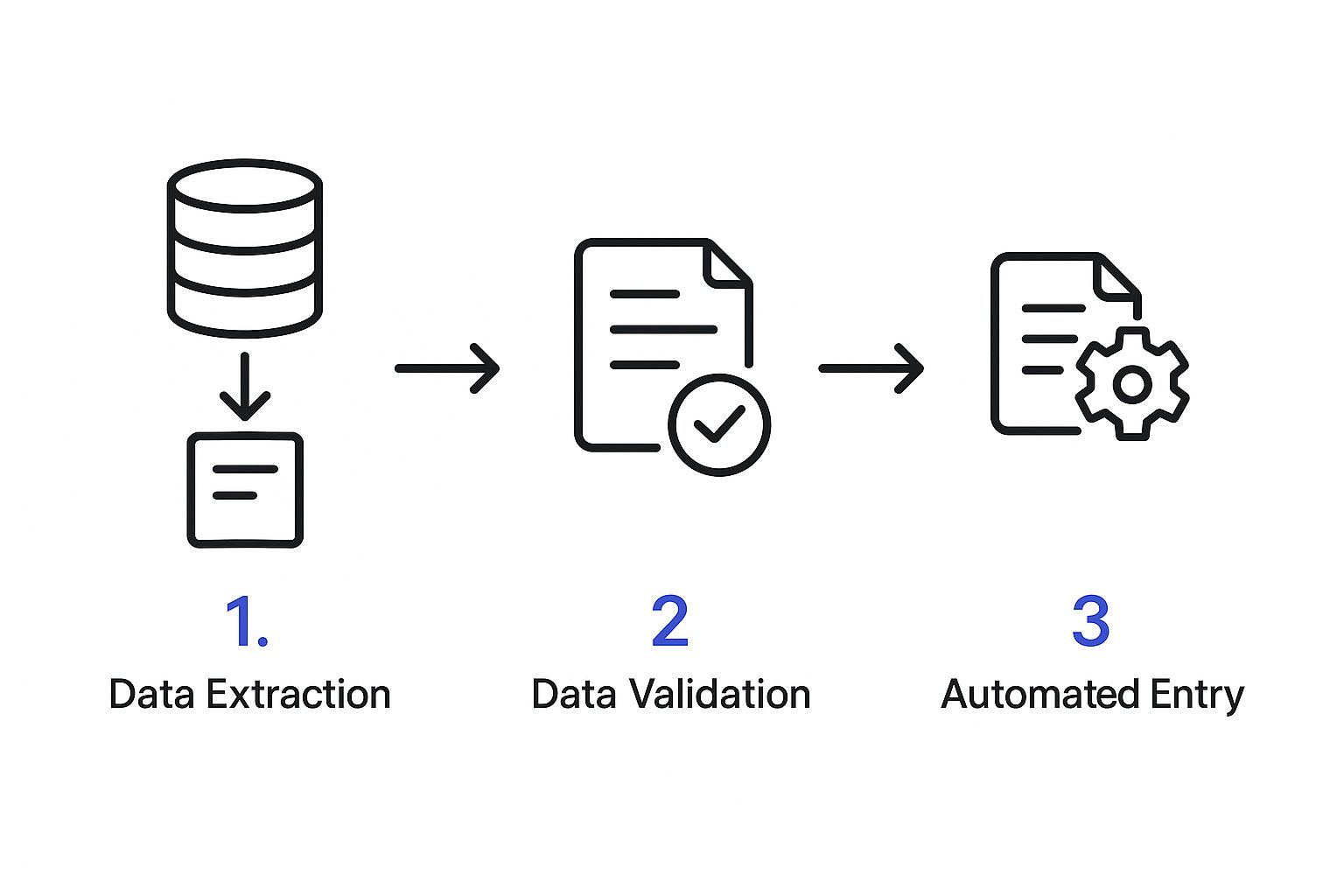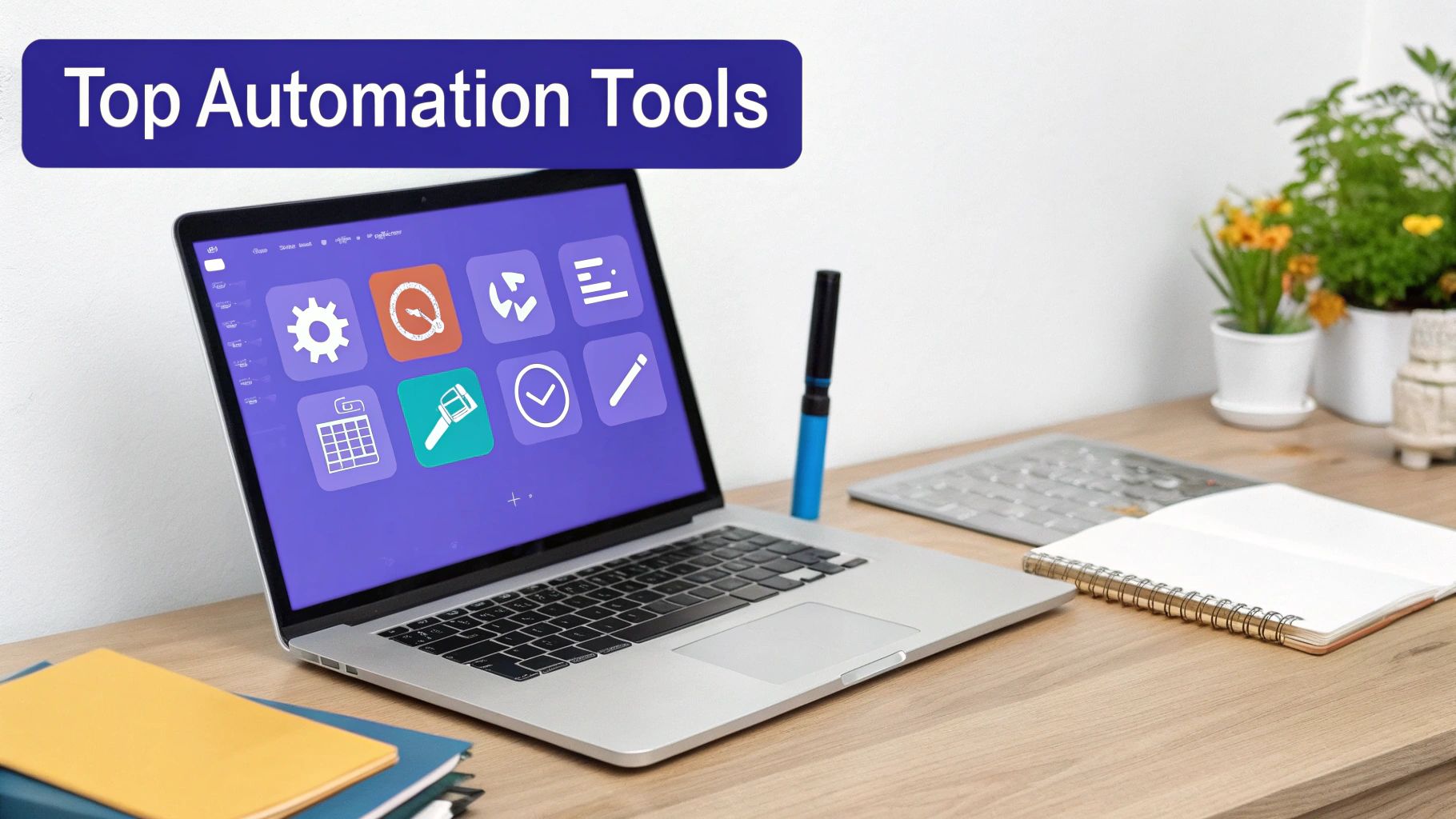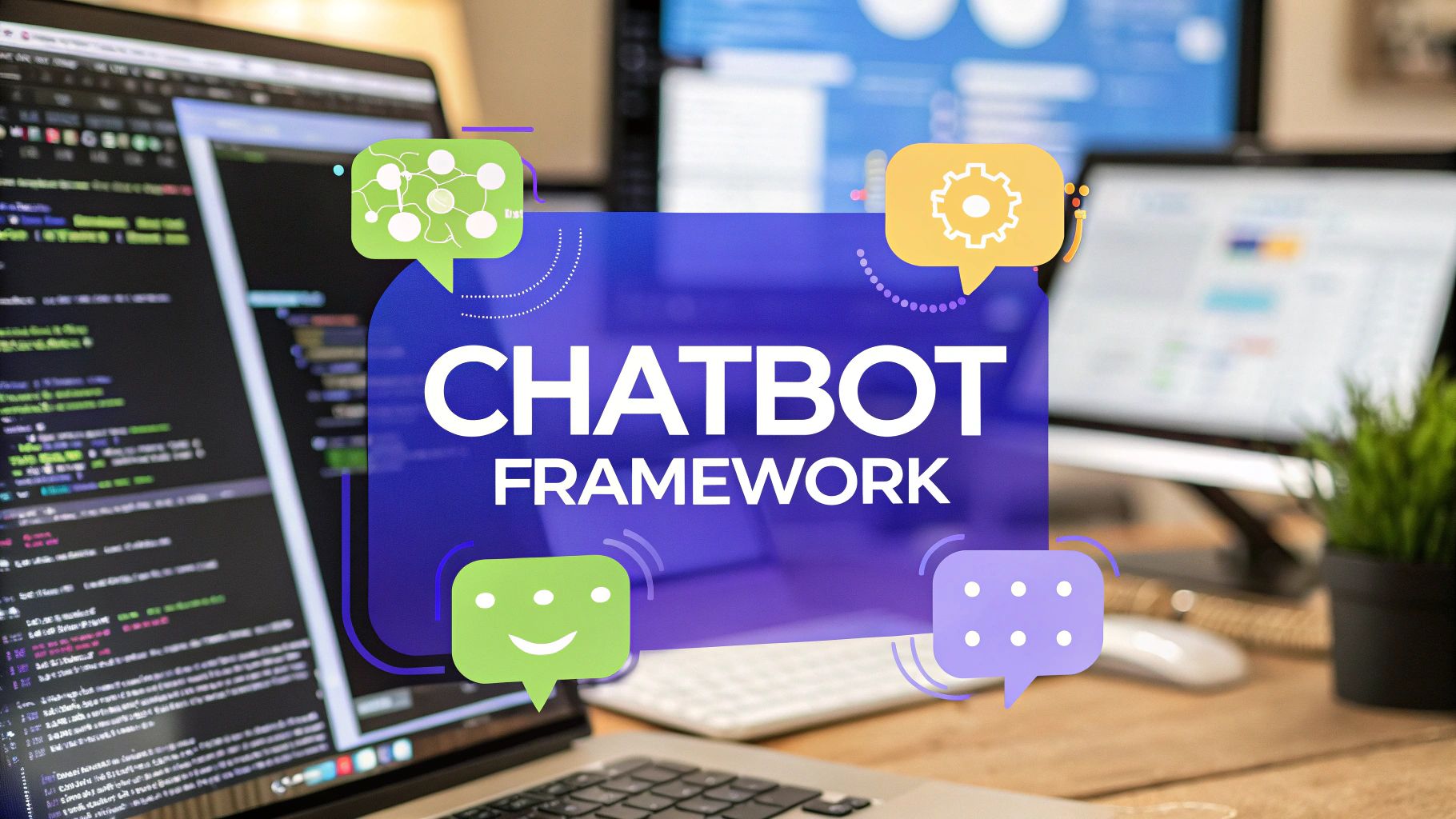Automate Data Entry And Reclaim Your Time
Discover how to automate data entry with practical strategies. Learn to use AI and RPA tools to reduce errors, save time, and scale your business operations.

If you're still relying on manual data entry, it’s time to make a change. The goal is to move away from those slow, error-prone spreadsheets and toward smarter, technology-driven workflows. This means bringing in tools like AI agents and Robotic Process Automation (RPA) to take over the repetitive tasks, which frees up your team to focus on things that actually grow the business. The result? A far more efficient, accurate, and scalable operation.
Why Manual Data Entry Is Holding You Back

Let's be honest: manual data entry is a quiet drain on your business. It’s not just about the hours spent typing; it's the compounding cost of human errors, the missed growth opportunities, and the burnout that comes from mind-numbing, repetitive work.
Every hour a skilled person spends copying and pasting information from an invoice into a spreadsheet is an hour they aren't spending on strategy or nurturing customer relationships.
This outdated approach creates a ton of operational friction. Data gets stuck in different systems, accuracy is always a question mark, and your ability to scale is seriously capped. As your business grows, so does the data, quickly turning a manageable task into an overwhelming bottleneck.
The Hidden Costs of Manual Processes
The true price of manual data entry goes way beyond employee salaries. Think about the cost of fixing mistakes, dealing with compliance headaches from inaccurate records, and making bad business decisions based on faulty data. These are the hidden costs that silently eat away at your bottom line.
Just consider the ripple effect of one tiny mistake:
- An incorrect invoice amount can sour a client relationship for good.
- A typo in a shipping address leads to costly returns and frustrating delays.
- Inaccurate inventory counts mean you either run out of stock or tie up cash in products that aren't selling.
These aren't just hypotheticals. For businesses that haven't automated data entry, this is just another Tuesday.
To put the difference into perspective, here’s a quick comparison between manual and automated data entry. The numbers really speak for themselves.
Manual vs Automated Data Entry: A Quick Comparison
As you can see, the gap is massive. Automated systems not only work faster but also maintain a level of accuracy that humans simply can't match over long periods.
The impact of automation is staggering. By 2025, automation will have revolutionized data entry by dramatically cutting down manual work. Recent studies show that automation reduces manual data entry tasks by approximately 80%. Furthermore, automated systems achieve accuracy rates between 99.959% and 99.99%, a significant leap from human accuracy which typically ranges from 96% to 99%. Learn more about the statistical impact of data automation.
Introducing Intelligent Automation
The solution is what we call intelligent automation, which brings together technologies like AI and RPA. Think of RPA as a "digital worker" that can mimic human actions—clicking, typing, and navigating through apps—to handle straightforward, rules-based tasks.
But when you layer in AI, things get really powerful. The system can now understand context, read unstructured documents like PDFs or emails, and make smart decisions on its own.
This combination lets you build end-to-end workflows that just run. For instance, an AI agent can open an email, spot an attached invoice, pull out key information like the vendor name and total amount, and then hand that data to an RPA bot that plugs it right into your accounting software. The entire process happens automatically, 24/7, without a single human touch.
Finding Your First Automation Opportunities

The secret to a winning automation strategy isn't trying to boil the ocean. You'll get much further, much faster, by finding the right place to start—a project that delivers a big impact with minimal upfront effort.
Not all tasks are created equal, and some are far better candidates to automate data entry than others.
A practical audit of your current workflows is the best way to kick things off. The goal here is to pinpoint the most repetitive, high-volume, and rule-based tasks that are draining your team's time and attention.
Identifying Prime Automation Candidates
Think about the daily or weekly tasks that nobody on your team wants to do. These are almost always your prime candidates. A great starting point is any process that involves moving information from one system to another without a lot of thought or analysis.
Consider these all-too-common scenarios:
- Invoice Processing: Manually keying in vendor details, line items, and payment amounts from PDFs or emails into your accounting software.
- Customer Data Management: Copying new lead information from a web form or email straight into your CRM.
- Order Fulfillment: Transferring shipping details from your e-commerce platform over to your logistics provider’s portal.
Each of these examples shares a common thread: they're predictable and follow a clear set of rules. For a deeper dive into how this looks in practice, you can explore these detailed business process automation examples and see how different industries are tackling similar challenges.
A key insight I've learned over the years is that the best first project is one where you can clearly measure the "before" and "after." If you can say, "This task used to take us 10 hours a week and now it takes 10 minutes," you have a powerful business case to expand your efforts.
Pinpointing Your Bottlenecks
Once you have a list of potential tasks, it's time to get focused. Look for the biggest bottlenecks—the specific points in a workflow where things slow down, errors pile up, or handoffs get clumsy. This is where automation delivers the most significant ROI.
Ask yourself these questions to zero in on your top priority:
- Which task has the highest volume of transactions daily or weekly?
- Where do the most costly or frequent errors occur?
- Which process relies on a system that is difficult to access or use, like a clunky legacy portal?
For instance, a retail company we worked with discovered their biggest bottleneck was manually updating inventory levels between their online store and their warehouse management system. This single point of failure led to stockouts and frustrated customers.
Automating just this one data sync completely changed their operations, proving the value of the project almost immediately. Choosing the right first project builds momentum and makes it much easier to get buy-in for whatever you want to tackle next.
Building Your First Automated Data Workflow
Alright, let's get our hands dirty and move from theory to practice. This is where you’ll see just how simple it is to automate data entry with the tools available today. We're going to build a workflow for a super common task: grabbing data from emailed invoices and dropping it into a Google Sheet for easy tracking.
The best part? You don't need a computer science degree or even a single line of code. Platforms like Chatiant are built to be intuitive. They let you connect your favorite apps and create powerful automations with a visual, drag-and-drop interface. It’s all about getting a quick win and showing your team what’s possible.
Setting Up Your Trigger and Action
Every automation needs a starting pistol—an event that kicks the whole thing off. This is your trigger. For our invoice example, the trigger is a new email landing in a specific folder, maybe one you’ve set up just for invoices. Simple as that.
Once that trigger fires, a series of actions follows. Think of it less as one big step and more like a chain reaction. First, the AI agent has to look at the email’s attachment (the invoice). Next, it needs to pull out the specific details you care about. Finally, it adds that information as a new row in your Google Sheet.
It's like a set of digital dominoes falling one after another:
- Trigger: A new email with "invoice" in the subject line arrives in
invoices@yourcompany.com. - Action 1: The Chatiant AI agent opens and reads the attached PDF invoice.
- Action 2: The agent finds and extracts key info: Invoice Number, Vendor Name, Due Date, and Total Amount.
- Action 3: The agent zips over to your Google Sheet and neatly fills in a new row with that data.
This whole sequence unfolds in seconds, completely hands-free.
Training Your AI Agent for Extraction
This is where the real magic happens: teaching the AI what data to grab. It sounds way more complicated than it is. With Chatiant, you just show it a few examples of your invoices and point to the data you want. You might highlight the "Total" and label it invoice_total or click on the date and call it due_date.
A pro tip I always give is to start with a consistent document type. If you get a lot of invoices from one or two major vendors, use those for your first training batch. The AI quickly learns the layout, which makes the data extraction incredibly accurate from day one.
After you’ve shown it just a handful of examples, the AI agent starts to recognize these fields on new invoices it has never seen before, even if the formatting is a bit different. This is what makes modern AI so much more powerful than older, rigid automation tools. The process is clean and direct.
This flow shows the core logic: the AI pulls the raw info, checks it against your rules, and then passes it to the destination system.

The key takeaway here is the seamless handoff from one stage to the next. This is what gets rid of the manual review and correction cycles that bog down so many businesses.
Connecting Your Apps and Going Live
The final piece of the puzzle is connecting the dots. Using Chatiant’s built-in integrations, you'll securely authorize access to your email account (like Gmail or Outlook) and your Google account. It’s a one-time setup that gives the platform permission to work on your behalf.
With everything connected, you just map the fields. You’re essentially telling the workflow, "Take the invoice_total the AI extracted and put it in the 'Amount' column of my Google Sheet." Once you’ve mapped all your fields, you can run a quick test to see it in action.
If it all looks good, you hit the "activate" button. From that moment on, your new workflow will run quietly in the background, saving you hours of mind-numbing work every single week.
Integrating Automation Across Your Business

It’s one thing to have an isolated workflow that neatly moves data from an email into a spreadsheet. That's a great first step. But the real magic happens when you automate data entry across your entire business ecosystem. A connected automation is always more powerful than one working in a silo.
This is where you move beyond single tasks and start thinking about end-to-end processes. How can customer info flow from your CRM to your ERP and then into your accounting software without anyone lifting a finger? The answer is integration.
Creating Seamless Data Flows
Modern AI platforms like Chatiant are built to communicate with the other tools you rely on daily. They do this using APIs (Application Programming Interfaces) and pre-built integrations, which basically act as secure bridges between your different software systems.
Instead of your team manually copy-pasting data from one app to another, these integrations create a self-driving, interconnected network. Information silos crumble as data moves freely and accurately to wherever it's needed most.
Let's look at a real-world example:
- A new lead fills out a form on your website.
- An AI agent instantly creates a new contact in your CRM.
- Once that lead converts to a customer, their details are automatically pushed to your ERP to set up an account.
- When their first invoice gets paid, that payment data lands in your accounting software.
This isn't just about saving a few minutes here and there. It’s about creating a single source of truth for your customer data, which is fundamental for making smart, timely business decisions.
From Task Automation to Process Transformation
When you get your systems talking to each other, you level up from simply automating tasks to true process transformation. This is where you start to see huge operational gains and a real competitive advantage.
The economic impact is massive. The global market for automation and control systems is on track to hit $226.8 billion, driven by enormous productivity boosts. In fact, more than 90% of workers say automation improves their productivity, and companies investing in it see an average 22% cut in operating costs.
Connecting your automations changes the game completely. Think of it like a relay race: a single fast runner is good, but a team that nails every handoff wins the race. Integration is the art of the perfect handoff between your business applications.
Unlocking End-to-End Automation
Connecting your tools opens the door to far more sophisticated workflows that can manage entire business functions. Imagine an AI agent that doesn’t just read an invoice but handles the whole accounts payable process from start to finish.
Or think about how this could transform customer support. Instead of just logging tickets, you can build a workflow that actually solves problems. Our guide on help desk automation dives deep into this, showing how integrated systems can check a customer’s order status in your ERP, review their conversation history in your CRM, and deliver a personalized, accurate response—all automatically.
This level of integration turns reactive, manual work into proactive, automated systems that run 24/7. It finally frees your team from the grind of data management, letting them focus on the high-value, strategic work that actually grows your business.
Alright, you’ve got your first automated data workflow humming along. That’s a fantastic win, but it’s really just the starting line. The real challenge—and the real payoff—comes when you scale those efforts from a single task into a company-wide program that delivers serious value.
Going from one automated process to ten, or even a hundred, can get messy fast. Without a solid plan, you'll end up with a collection of disconnected, fragile bots that break easily and are a nightmare for anyone but their original creator to manage. Let's talk about how to scale smart and avoid those headaches.
Establish Clear Process Ownership
As you start to automate data entry in more departments, the first thing you need to do is assign a clear owner to every single process. It's not a question of if an automation will break, but when. A website gets updated, a document format changes—and suddenly, the workflow stops. Someone needs to be on the hook for noticing and getting it fixed.
This process owner doesn't need to be a technical whiz. They just need to be the person who deeply understands the business goal of that workflow. For example, the accounts payable manager should "own" the invoice processing automation. They might not be the one tweaking the AI agent, but they'll be the first to know when it's not working and can flag the right person to jump on it.
Build for Resilience with Error Handling
Your automations are going to run into things you didn't expect. An email will show up without an attachment, a PDF will be corrupted, or a website will be down for maintenance. Robust error handling is what makes an automation tough enough to handle the real world.
A common mistake is building automations that only work on a perfect day. But the truth is, around 70% of digital transformation projects don't hit their targets, often because of simple implementation issues like poor error handling. You can discover more insights about automation project statistics.
You don't need anything complex. Just set up simple, effective alerts. If a workflow fails, it should automatically send a notification to the process owner via email, Slack, or Google Chat. This alert needs to include the basics, like which step failed and a clue as to why, so they can start troubleshooting immediately.
Keep Documentation Simple and Accessible
You don’t need to write a novel for every automation, but simple, clear documentation is absolutely essential for scaling. This is how you prevent crucial knowledge from being trapped in one person's head.
A good rule of thumb is a one-page summary that covers:
- Purpose: What business problem does this automation actually solve?
- Owner: Who is the go-to person for this process?
- Trigger: What kicks off the workflow (e.g., a new email in a specific inbox)?
- Core Systems: What apps does it touch (e.g., Gmail, Salesforce, Google Sheets)?
Keep this information somewhere central and easy to find, like a shared drive or a company wiki. It makes it incredibly easy for anyone on the team to understand what an automation does and who to talk to about it. This is also a lifesaver for training new team members. For a deeper look at how these principles apply in a specific department, our guide on customer support automation shows just how vital these clear processes are for success.
Moving from one-off automations to a full-fledged program requires a bit more structure. This checklist can help your team stay aligned as you grow.
Automation Scaling Checklist
Using a checklist like this ensures everyone is on the same page and that you’re building a scalable, resilient automation program—not just a collection of disconnected tasks.
Common Questions About Data Entry Automation
When you first start looking into automation, it’s natural to have questions. It's one thing to hear about the benefits, but it’s another to figure out how it actually works for a business like yours—especially if you're not a huge corporation.
Let's clear up some of the most common worries people have before they automate data entry. My goal here is to give you straight answers so you can feel confident making the jump.
What Is the Real Cost to Get Started?
This is usually the first question on everyone's mind. There's a common myth that automation means a massive, six-figure software project. Thankfully, that's old news. Modern tools have completely changed the game.
Today, most AI platforms run on a simple subscription model. For a predictable monthly fee—often less than what you’d pay a freelancer for a few hours of work—you can get started. The real cost isn't the software; it's sticking with manual processes that are quietly bleeding money through errors and wasted staff time.
How Long Does It Take to Set Up a Workflow?
Getting your first automation up and running is way faster than most people think. A simple, high-impact workflow, like pulling data from invoices into a spreadsheet, can honestly be built in under an hour. You don't need to be a developer or hire one.
The secret is starting with a process you already know inside and out. If you can clearly say, "I need this info from this document to go there," you can build a working automation on a platform like Chatiant in a single afternoon.
The whole setup is designed to be visual and intuitive. You just connect your apps (like your email and your accounting software), show the AI a few examples of what to look for, and map the fields. It’s a straightforward way to get a quick win and see immediate results.
Can Automation Handle Messy, Unstructured Data?
This is a huge one, and the answer shows just how far AI has come. Older automation tools were rigid. They needed data to be in the exact same spot on every single document, which is just not realistic.
Today's AI is built differently. It uses a mix of Optical Character Recognition (OCR) and newer Vision Language Models (VLMs) to read documents the way a person does. It understands context, not just position. This means it can easily handle the messy, real-world data you deal with every day.
- PDF Invoices: Even if your vendors all use different layouts, the AI can reliably find the invoice number, due date, and total amount.
- Emails: It can scan the body of an email to pull out a customer's order details or a support request.
- Handwritten Notes: Some advanced systems can even turn messy handwriting into clean, structured data you can actually use.
This ability to adapt to variability is what makes modern automation so practical. These tools are built for the inconsistencies of normal business operations, making automation a real possibility for everyone, not just the big players.
Ready to stop wasting time on manual data entry? With Chatiant, you can build your first AI-powered workflow in minutes, not months. Start automating your processes today.


